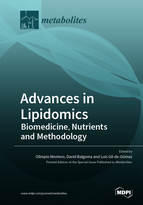Advances in Lipidomics: Biomedicine, Nutrients and Methodology
A special issue of Metabolites (ISSN 2218-1989). This special issue belongs to the section "Lipid Metabolism".
Deadline for manuscript submissions: closed (1 July 2020) | Viewed by 40667
Special Issue Editors
Interests: lipidomics; metabolimics; mass spectrometry; chromatography
Special Issues, Collections and Topics in MDPI journals
Interests: lipid metabolism; lipogenesis; lipidomics; mass spectrometry
Special Issues, Collections and Topics in MDPI journals
Special Issue Information
Dear Colleagues,
Lipidomics, a primary branch of metabolomics, has rapidly developed into a discipline of research of its own. This feature has arisen from robust evidence of lipid reprogramming in the setting of metabolic disorders, cancer or cardiovascular diseases. The importance of the lipid composition in a variety of pathologies has been elucidated from alternative perspectives. Among these new perspectives, we find the dependence of membrane receptors on the lipid rafts and the impact of diet on the physiological lipid profile. Additionally, in the last decade, potential biomarkers for early diagnosis and novel therapeutic targets have emerged. For example, lipidome profiling is promising for improving clinical treatments such as cancer immunotherapy. The improvement in the applications in the clinics is in direct relation to technical development. Relevant advances in lipid analysis have been reached using soft-ionization techniques in mass spectrometry and new developments in data pretreatment. However, data pretreatment applied to compound identification/quantification and reproducibility continues to be an analytical limit of lipidomics. In this Special Issue, researchers from the lipidomics field are encouraged to submit manuscripts concerning both targeted and untargeted lipid profiling, which focus on biomedicine and health-related nutritional studies. In particular, reviews and original studies that bolster signaling pathways and their influence on metabolism are preferred. Reviews and original studies that delve into a broad range of methodological advances including instrumentation, sample preparation and workflows, bioinformatics-based data analysis, and databases are also especially welcome.
Dr. Olimpio Montero
Dr. David Balgoma
Dr. Luis Gil-de-Gómez
Guest Editors
Manuscript Submission Information
Manuscripts should be submitted online at www.mdpi.com by registering and logging in to this website. Once you are registered, click here to go to the submission form. Manuscripts can be submitted until the deadline. All submissions that pass pre-check are peer-reviewed. Accepted papers will be published continuously in the journal (as soon as accepted) and will be listed together on the special issue website. Research articles, review articles as well as short communications are invited. For planned papers, a title and short abstract (about 100 words) can be sent to the Editorial Office for announcement on this website.
Submitted manuscripts should not have been published previously, nor be under consideration for publication elsewhere (except conference proceedings papers). All manuscripts are thoroughly refereed through a single-blind peer-review process. A guide for authors and other relevant information for submission of manuscripts is available on the Instructions for Authors page. Metabolites is an international peer-reviewed open access monthly journal published by MDPI.
Please visit the Instructions for Authors page before submitting a manuscript. The Article Processing Charge (APC) for publication in this open access journal is 2700 CHF (Swiss Francs). Submitted papers should be well formatted and use good English. Authors may use MDPI's English editing service prior to publication or during author revisions.
Keywords
- Lipid profiling
- Lipid metabolism
- Nutritional lipids
- Signaling pathways
- Lipid analysis
- Mass spectrometry
- Bioinformatics for lipidomics









